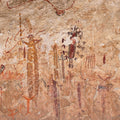Remembering the Topeka Bottoms
By Chadd Scott on
The story of Topeka Bottoms is both typical and unique. What happened to the Topeka Bottoms neighborhood in the mid-20th century occurred in hundreds of other thriving minority communities across America, but when it happened here, the victims, the people, the families, the houses, they experienced the trauma as individuals.
What happened was so-called “urban renewal.” Urban renewal was a widespread scheme throughout the country from the 1950s through the 1970s, imagined, designed, and carried out by white government officials, white engineers, white city planners, and white construction firms. Their stated intent was remedying “urban blight” and expanding the nation’s highway system to promote commerce and ease of transportation. Their actual intent was destroying thriving minority neighborhoods, reinforcing racial economic hierarchies.
“Urban renewal” was massively successful in achieving that latter goal.
“Urban renewal” did to African American and Hispanic communities what Manifest Destiny did to Native American communities 50 and 100 years prior. Obliterate them. Obliterate them in the name of progress. Of civilization. Tools of white nationalism.
Scraping Indigenous people off the land for farming and farmers, for ranching and ranchers, for railroads, was replaced by plowing interstate highways through prosperous, vibrant Black neighborhoods full of homes and churches and businesses and schools.
The practice took place from coast to coast, from New York to L.A. to Miami and everywhere in between. Tampa. St. Louis. Dallas. San Diego. Tulsa. Topeka.
University of Kansas Visual Art Professor and artist Maria Velasco is paying tribute to the Topeka Bottoms through her “Reclaiming Home: Remembering the Topeka Bottoms” exhibition on view at Arts Connect in Topeka through May 31, 2025.

‘Nothing Left But Memories,’ constructed, 2025. Courtesy of Maria Velasco. Copyright Arlo Paden.
“The story of urban renewal has always been told from the point of view of the white developers that make these decisions without taking into account the best interests of the communities affected,” Velasco said. “I was interested in bringing those stories to light. It felt urgent to me. The people left from those days are now in their 80s. It’s important the stories be captured and passed on.”
That’s where her project began, by talking to the remaining living Bottoms residents.
“Every single person – every single person – said that everybody cared about everybody. There was real solidarity. They shared everything. What a model for a local neighborhood to be diverse and solidary in their working-class condition,” Velasco said. “Out of the 40, 50 people we’ve interviewed, everybody’s talked about friends, family, friends being family. In their poverty, if dad came home with 20 small buns of bread, and there was a couple of extra kids running around with everybody else and they ended up at the table, they would give food to whoever was at the table or whoever knocked at the door who needed food or something.”
Yes, residents of the Bottoms were poor. The Bottoms neighborhood in Topeka and the Bottoms neighborhood everywhere else in America. Neighborhoods called “the Bottoms” were so named due to the land’s low-lying nature. The Bottoms were typically located by rivers, the Kansas River in this case. Prone to flooding. Prone to sewage runoff. The bottoms topographically and demographically.
This was the only land afforded African Americans and Hispanics for their homes.
Another example of how race is the defining feature of life and society in America and always has been.
While Bottoms residents were poor, they were also proud. Their homes may have been a little ramshackle, but they were often built by hand. By their own hands. They sheltered and protected their families without help from the city, thank you very much.
“The (homes) had several rooms, they had a porch, a backyard, and they lived really well; they didn’t know they were poor,” Velasco said.

‘Festival Dancers,’ Fiesta Mexicana, Topeka, Kansas, 1933. Copyright kansasmemory.org, Kansas State Historical Society.
Reclaiming Home
The “Reclaiming Home” multimedia art and oral history project results from nearly three years’ of work and will eventually include a documentary film of the same name. Velasco, an immigrant from Spain who first came to the U.S. on a study abroad grant, stumbled upon the story researching local history at the Topeka Library. She’d lived in Lawrence – 25 miles east – for 20 years while teaching at the University of Kansas, but hadn’t heard of the Bottoms. Even in Topeka, most people are unfamiliar with the Bottoms.
Velasco partnered with Matt Jacobson, professor of Film and Media Studies at KU, public historian Valerie Mendoza, and Neill Esquibel-Kennedy, archivist and visiting assistant professor of American Studies at KU, to collect the stories of former Bottoms residents and their descendants. Velasco’s work connected with other local grassroots efforts to remember the neighborhood.
To memorialize the Bottoms, Velasco has created more than two dozen tabletop models of homes from the neighborhood. Each one, a few inches high, represents a different person’s story.
“I could build something – not bring the houses back – but I could build homes. The difference between house and home. Those homes would be representing the neighborhood, and they would come together with the stories,” Velasco said. “I would go through the interviews and select a quote that struck me, that added a new or different perspective to this neighborhood that I ended up constructing based on people’s testimonies. The idea came from rebuilding these homes with words.”

‘Nothing Left But Memories,' 2025. Courtesy of Maria Velasco. Copyright Arlo Paden.
Text from Bottoms residents form the walls of Velasco’s homes.
In addition, for each of the 39 storytellers, the artist created a portrait and a postcard that includes a QR code leading to a video of that person’s story. Visitors can take one of the cards home. The exhibition also includes a large wall display of the cards, and artwork based on an old Sanborn fire insurance map, the only map that exists of the neighborhood.
“Every time we’ve met storytellers, we always bring the map and people gather to look for their house and to remember,” Velasco said. “They remember so well where they lived, who was around, who was on the corner, the path to school. It’s a vivid piece they relate to that I wanted to incorporate into the work.”
Velasco’s homes use a hand silkscreened copy of the map as their roof. The walls and roof are held together by magnets, making them easy to assemble and disassemble. A symbolic reference, too.
“The homes come together because people come together, because people come together to talk and to remember and rekindle the memories,” Velasco said.
A group of former Bottoms residents has been reuniting annually for 30 years – the Kids Bottoms reunion. Black and Hispanic.
“(The Bottoms) was well populated by Mexican immigrants who came to Kansas at the turn of the century mostly to work on the railroad,” Velasco explained. “Some of the first homes that were put in for railroad workers were boxcars. A lot of these families lived in boxcars. Can you imagine a boxcar in the summer in Kansas? Can imagine a boxcar in the winter in Kansas?”
The Bottom’s Mexican influence is fondly remembered via the beloved Pedro Lopez store selling Mexican food products that was there. Pedro Lopez came to Topeka from Mexico in the early 1900s. He started a small business delivering Mexican food products around town that grew into a large business selling a full suite of Mexican food products.
All gone now.
“(The city) bulldozed over 20 blocks,” Velasco said. “Some of those were historic buildings that were demolished. That makes my heart cringe. Even more than that, the people that were displaced.”
Living former residents can identify individual trees remaining here and there, but the destruction “urban renewal” brought to the Bottoms was total. It is now a lifeless industrial area populated by warehouses and Interstate 70. Interstates always featured into urban renewal projects so local municipalities could tap into federal funding. Local, state, and federal government – your tax dollars – paid for the destruction of these neighborhoods, the displacement of these people.
“There’s nothing. There’s nothing left,” Velasco said. “What is left is asphalt and warehouses. It’s only drivable. There’s no one there. It’s no longer a neighborhood.”
“Urban renewal” was a catastrophic failure everywhere it was practiced except to the white suburbanites who used the big, new roads to commute more easily to jobs in town. Lively, walkable neighborhoods for minority residents were replaced by multi-lane interstates, exchanges, and overpasses. Semi-truck noise and diesel exhaust. Gas stations where schools used to be.
The communities – the literal and figurative communities built in these places – destroyed by the engineers, city planners, and government officials without input from the impacted residents who were shoved out, scattered, and left to fend for themselves in looking for new homes.
Minority home ownership.
Minority small businesses and economic self-sufficiency never recovered in many of the affected areas.
It happened across America.
It happened in Topeka.



